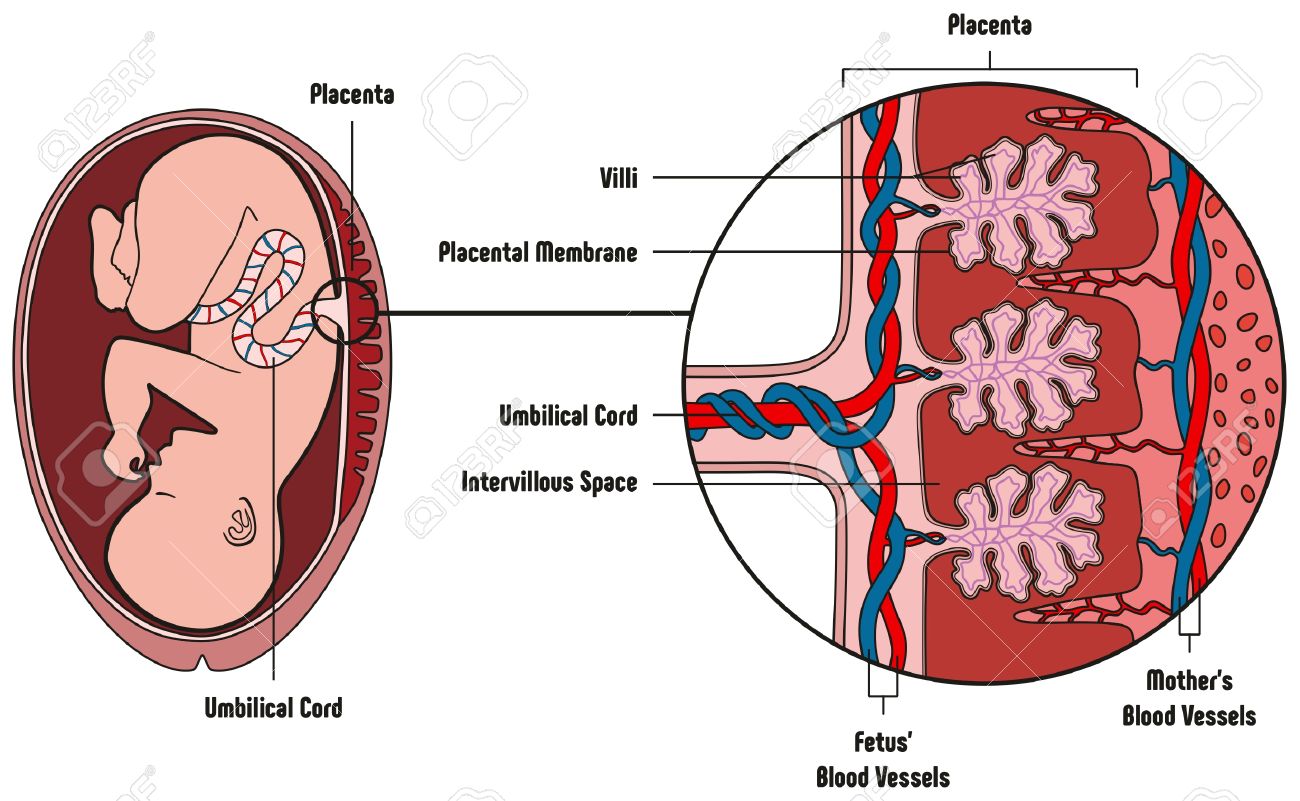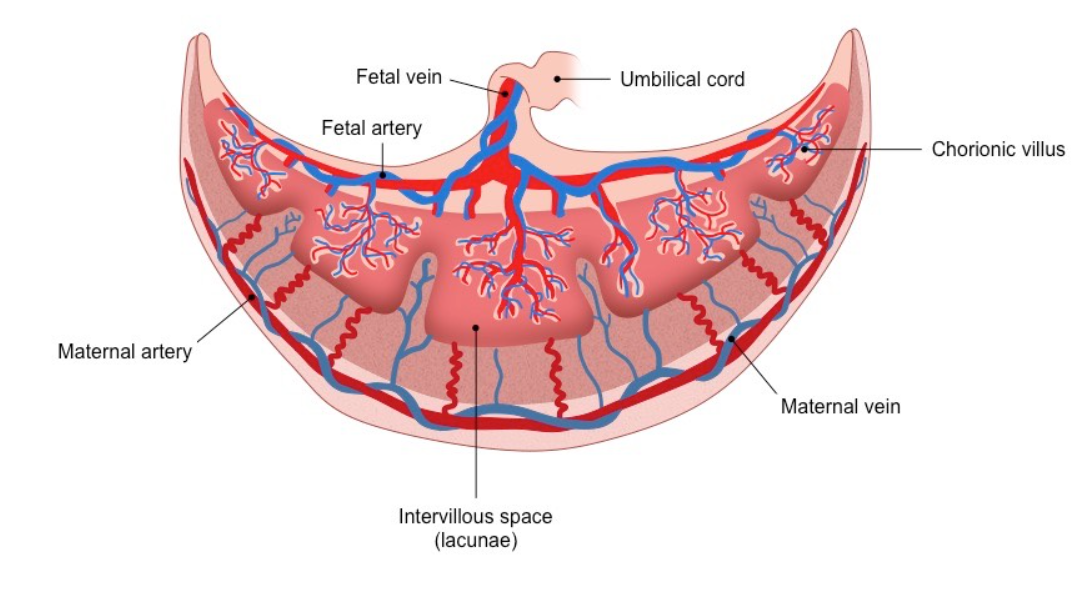The Placenta Study Guide
What is the Placenta?
Ever wondered how a baby breathes inside the womb or feeds itself? Inside the placenta, exchanges of nutrients and blood take place.
- A fully grown placenta comprises a dense network of blood arteries from both the fetus and the mother.
- Microscopic gaps close yet separate the fetal and maternal arteries.
- This permits the blood of the mother and fetus to exchange nutrients between their capillary walls without the blood directly combining.
- The umbilical cord, a tube with two arteries and a vein, connects the fetus to the placenta.
- The fetus’ blood reaches the placenta via the umbilical arteries, interchange gases, and other substances with the maternal blood, and returns to the fetus via the umbilical cord.
How does the Placenta work?

- Under pressure, blood from the mother penetrates the maternal blood arteries of the placenta, pushing it into the empty gaps.
- Gases are exchanged when the mother’s blood hits the fetal blood vessels. The exchange of oxygen from the mother’s blood for carbon dioxide from the fetus’s blood happens hereafter.
- A pressure discharge forces the mother’s blood back into her veins from the placenta.
- The umbilical cord, a tube with two arteries and a vein, connects the fetus to the placenta. The fetus’ blood reaches the placenta via the umbilical arteries, interchange gases with the maternal blood, and returns to the fetus via the umbilical cord.
- Apart from the gaseous exchange, the placenta transports nutrients, hormones, and other essential compounds from the maternal blood to the fetus’s blood.
- The placenta also removes numerous dangerous compounds from the maternal blood, preventing them from passing on to the fetus.
- Furthermore, the placenta expels hormones that keep the corpus luteum in the mother’s ovary functioning.
Remember: the corpus luteum secretes progesterone, which is required to protect the uterine endometrium from disintegrating.
Structure of a Placenta
- The chorion is the fetal component of the placenta, whereas the decidua basalis is the mother’s component.
- The chorion’s exterior surface is covered with a set of finger-like projections that develop into the uterine tissue when these villi permeate the mother’s uterine wall tissue.
- In the placenta, the fetal blood comes relatively close to the mother’s blood, allowing for the exchange of nutrients. Food (glucose, organic molecules, lipids), fluids, essential minerals, vitamins, hormones, immunoglobulin, and oxygen are transported from the mother’s blood to the fetal blood. In contrast, metabolic byproducts such as carbon dioxide, urea, and toxins are transported from the fetal blood to the maternal blood.
- The placenta serves as the fetus’s digestive, respiratory, and excretory organ.

Functions of placenta
- Nutrition: The Placenta helps food elements flow from the maternal blood into the fetal blood via the umbilical vein.
- Digestion: Protein is metabolized by the placental trophoblast before it enters the fetal bloodstream.
- Respiration: Through the placenta, oxygen travels from the mother to fetal blood, and carbon dioxide disperses from fetal blood to maternal blood.Excretion: Nitrogenous wastes pass through the placenta and are cleared out by the mother’s kidneys.
- Storage: The placenta stores glycogen, lipids, and other resources for the baby before the liver develops.
- Barrier: The placenta acts as a strong shield that permits helpful components to reach blood circulation. The placenta permits hazardous substances such as nicotine from cigarettes and addictive drugs to pass through. Therefore, pregnant women should abstain from smoking and drug use. Viruses and bacteria can also pass through the placenta.
- Endocrine function: As an endocrine gland, the placenta secretes hormones such as estrogen, progesterone, and human chorionic gonadotropin (HCG).
Placenta and related Structures
Amniotic sac and fluid
The amniotic sac, attached to the placenta, protects and shields the embryo or baby. It starts to develop around a week after fertilization. It quickly fills with water and dissolved chemicals, forming amniotic fluid. The fluid permits the fetus to move around freely until it fills the majority of the space available. The fluid also protects the fetus from damage by cushioning it.
The placenta is a link between the fetal membrane and the uterine wall. As a result, the placenta has both maternal and embryonic characteristics. The developing embryo absorbs nutrients and oxygen from the mother through the placenta while generating carbon dioxide and nitrogenous waste.
Conclusion:
- The fetus cannot grow and develop without oxygen and nutrients from the mother.
- Wastes from the fetus are also required to be removed for the fetus to survive.
- The exchange of these substances between the mother and fetus occurs through the placenta.
- Hence, the placenta is an important temporary organ during pregnancy.
FAQs:
1. What is the placenta responsible for?
The placenta is vital to maintaining your baby alive and healthy during pregnancy. It is an organ linked to the uterine lining that provides oxygen and nutrition to the developing infant.
2. What is the placenta, and what is it responsible for?
The placenta is a mother’s organ that grows from the developing fetus and connects to the uterus. The placenta is in charge of, among other things, giving oxygen and nourishment to the developing fetus while also eliminating contaminants.
3. Why do people eat the placenta?
Some believe that nutrients given from mother to fetus throughout pregnancy are still stored inside the bleeding organ and must not be lost. Conversely, the raw placenta may be exactly what the woman requires as she recuperates from delivery and begins nursing.
4. What are the 5 functions of the placenta?
Gas exchange, metabolic transfer, hormone production, and respiratory and excretory and embryonic protection are all functions of the placenta.
5. What do hospitals do with the placenta after birth?
Placentas are treated as medical waste or biohazard material in hospitals. The infant placenta is stored in a biohazard bag. Some hospitals store the placenta for some time if it has to be sent to pathology for further examination.
6. Where does the placenta go after birth?
After delivery, the placenta usually separates from the uterine wall.
7. What is the placenta made of?
The placental layer is where the mother and fetus exchange fluids, nutrition, and other substances. The membrane is formed by the syncytiotrophoblast, cytotrophoblast, embryonic connective tissue (Wharton’s jelly), and fetal blood vessel endothelium.
8. Is the baby inside the placenta?
With the assistance of a fetal life-support system made up of the placenta, umbilical cord, and amniotic sac, the baby develops inside the uterus.
9. Does the placenta decide baby gender?
The fetus is female if the placenta develops on the left side. And is male if it develops on the right. However, further studies are still on for this subject.
10. How is the placenta connected to the embryo?
The umbilical cord, a tube with two arteries and a vein, connects the fetus to the placenta.
We hope you enjoyed studying this lesson and learned something cool about the Placenta! Join our Discord community to get any questions you may have answered and to engage with other students just like you! Don’t forget to download our App and check out our awesome VR room for this guide – we promise, it makes studying much more fun 😎
]]>